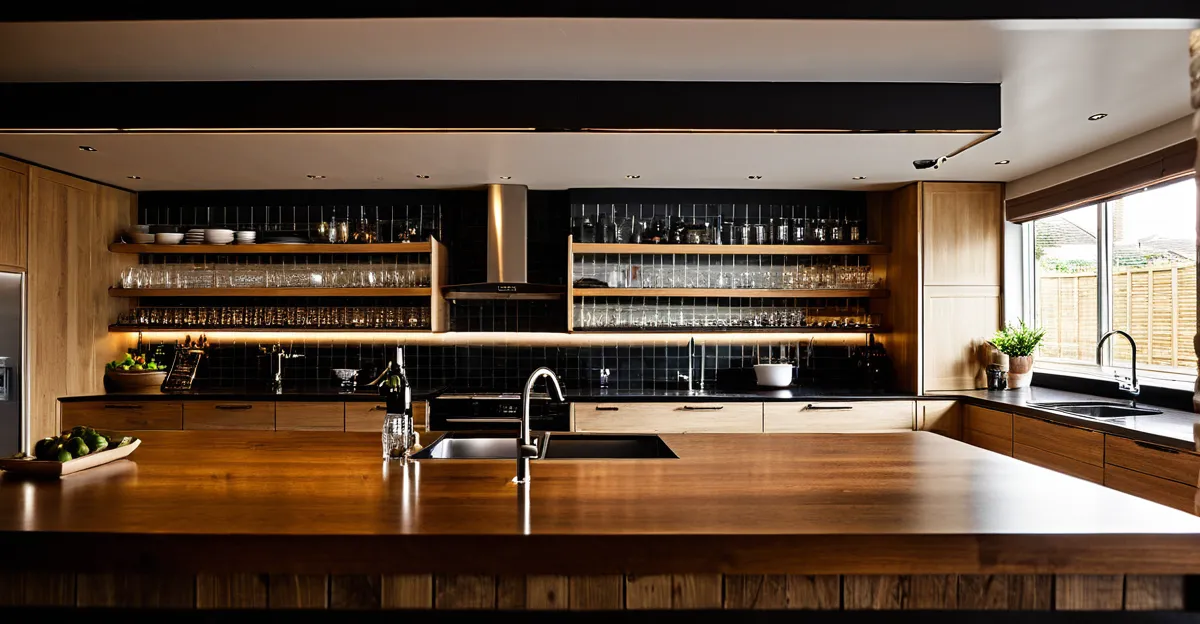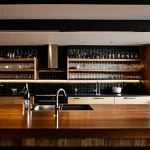Historical transformation of UK kitchen bars
Kitchen bars in the UK trace their origins back to postwar Britain, when the kitchen bar concept first emerged as a way to create informal social spaces within homes. Initially, kitchen bars served as practical breakfast nooks or casual dining areas, reflecting a shift from formal dining rooms to more relaxed family environments.
Throughout the late 20th century, the evolution of kitchen bars mirrored wider changes in British kitchen design. The 1960s and 70s saw kitchen bars become more integrated into open-plan layouts, facilitated by increasing urbanization and smaller living spaces. This design shift encouraged interaction between family members and guests, blurring boundaries between cooking and socializing.
This might interest you : Enhancing culinary magic: transformative uk kitchen design secrets
Social trends and family dynamics greatly influenced kitchen bar adoption. Growing emphasis on family togetherness and entertaining at home made kitchen bars a popular feature. They offered versatility—acting both as a casual dining spot and a hub for conversation. This trend reflected broader changes in society, including more informal lifestyles and the need for multifunctional living areas.
Today, the historical adoption and evolution of the kitchen bar in UK homes exemplify how British kitchen design adapts to cultural and social needs, balancing practicality with social engagement.
Also to see : Exploring the distinctive design features of uk kitchen bars: what sets them apart?
Recent trends in kitchen bar design and function
The modern kitchen bar trends UK strongly reflect the shift towards open-plan living, where kitchen bars serve as versatile focal points. Open-plan layouts encourage seamless interaction between cooking, dining, and relaxing areas, turning kitchen bars into multifunctional spaces. These bars are no longer just for casual dining; they double as informal work zones, entertainment hubs, and social gathering spots, enhancing both kitchen bar functionality and overall home usability.
In UK homes, popular materials for kitchen bars include durable natural stones like quartz and granite, combined with sleek, matte finishes or warm wooden textures. This choice balances aesthetics with practicality, supporting high traffic and spills. Alongside materials, technology integration is increasingly significant. Built-in USB ports and ambient LED lighting allow kitchen bars to adapt to various activities—from evening parties to focused work sessions—highlighting the fusion of style and utility in contemporary design.
These trends demonstrate a clear preference for flexibility and integration, ensuring that kitchen bars complement the modern lifestyle’s demands without sacrificing visual appeal or function. Exploring these designs can provide practical solutions tailored to your home’s unique needs.
Responding to changing consumer tastes and lifestyles
Recent consumer kitchen preferences UK reveal significant shifts driven by evolving lifestyles. Urban living encourages compact, multifunctional kitchen designs. Limited space means consumers prioritize storage solutions and efficient layouts more than ever.
Remote work has altered how people use their kitchens. Many now seek kitchens that double as social hubs or home office extensions. This trend reflects a desire for environments that support varied daily activities, blending cooking with work and leisure.
Health consciousness also strongly influences choices. Buyers increasingly prefer kitchens that accommodate meal prepping and clean eating habits, highlighting practical, easy-to-clean surfaces. Natural materials and sustainable designs are gaining popularity as well.
Industry experts emphasize the need for manufacturers to integrate these trends into design strategies. They suggest flexible designs tailored to diverse needs, such as adjustable counters and smart appliances that promote convenience and wellness.
In summary, adapting to these changes requires understanding how lifestyle kitchen design intertwines with consumer priorities shaped by modern life. Keeping pace with the latest kitchen trends statistics helps creators deliver spaces that resonate with today’s users effectively.
Future outlook: where UK kitchen bars are heading
In the next decade, future kitchen bar trends UK will be shaped by a mix of innovation and evolving lifestyles. One key shift involves integrating smart technology seamlessly into kitchen bars. Voice-activated lighting, app-controlled refrigeration, and modular designs will make these spaces more adaptable and intuitive. Consumers increasingly value convenience and personalization, driving demand for versatile kitchen bars that serve as social hubs and functional zones.
Sustainability will also influence future kitchen bar trends UK. Expect materials prioritizing eco-friendliness, such as recycled composites and energy-efficient appliances, to gain traction. This aligns with the broader push toward greener living that consumers embrace.
A notable example shaping this direction is a London-based kitchen outfitter experimenting with AI-driven layouts, predicting how users interact with their kitchens to optimize space and ergonomics. These case studies reflect a broader move from static to dynamic kitchen bars, highlighting innovation in kitchen design.
Forecasts indicate that kitchen bars in the UK will evolve beyond mere aesthetic features, becoming personalized, tech-savvy, and environmentally conscious hubs—trends that underscore the future of modern home living.


